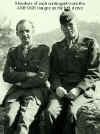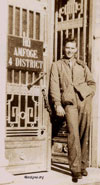|
insigne.org |
The Allied Mission to Observe the Greek Elections by
Les Hughes |
|
|
|
The bitter civil strife that engulfed Greece after Axis forces had been driven from its soil was in keeping with the bloody history of the Balkans. Four and a half years of dictatorship, during which all political parties had been suppressed, was followed by a long period of Axis occupation. With the liberation of Greece came not peace but rather open warfare between factions of the Right, represented by the Government, and the Left, the dominant faction of which was the Communist Party. The fighting was brought to an end on February 12, 1945, by the signing of the Varkiza Agreement, which followed by one day the publication of the Yalta Declaration on Liberated Europe, in which the United States, Britain, and Russia formally assumed responsibility for assisting liberated nations "to form interim governmental authorities representative of all democratic elements in the population through free elections... and to facilitate where necessary the holding of such elections." The Varkiza Agreement provided for a plebiscite, to determine whether Greece was to be a monarchy or a republic, to be followed by parliamentary elections. While the Varkiza Agreement ended the open fighting, it did nothing to reconcile the warring factions, and divisions remained deep. The mutual distrust among the factions led to the inclusion in the Agreement of a provision requesting that the Allied powers send observers to monitor the elections and verify their fairness. Even before the Varkiza Agreement, the British and American ambassadors in Athens had concluded that impartial observers would be essential if the Greeks were to arrive at any resolution of their problems, and they communicated to their respective governments the suggestion that an international commission be formed to monitor the plebiscite, which at that time was to precede the elections. The Varkiza Agreement led to negotiations between the Greek Government and the Governments of the United States and Britain, and later with those of France and Russia. The Governments of Britain, France, and the United States announced on September 19, 1945, that they had accepted the Greek Government's invitation to send observers. Russia, however, refused to participate on the grounds that it was opposed in principle to the supervision of national elections by foreign countries. (A widely held belief at the time was that the Russians chose not to participate for fear that if they did it might open the door to outside observers for elections scheduled to take place in Poland later that year.) The Greek Government had by now concluded that the elections should precede the plebiscite, perhaps as early as that autumn. But the previous 10-year disruption of normal Greek life had taken its toll, and the realization that the compilation of voter lists—the last having been compiled in 1935—would be more difficult than anticipated led to a series of post-ponements of the election. Finally, the elections were set for March 31, 1946. During the early stages of planning, the proposed organization of Allied observers was unofficially designated the Allied Mission for Observing Greek Elections. This was officially supplanted by the Allied Mission to Observe the Greek Elections. First designations, like first impressions, tend to be lasting, and so it is that veterans of the Mission, and even the Mission's final report [1], refer to the organization as AMFOGE. The heads of AMFOGE's contingents were Henry F. Grady (USA), R. T. Windle (Britain), and Gen. Arnaud Laparra (France). The military planning staff was headed by an American, MG Harry J. Malony, and comprised principally American officers. AMFOGE's strength at the outset of operations was 1,155, of which the United States provided 601 military and 91 civilian personnel; the French 164 military and 5 civilians; and the British 273 military and 21 civilians. Britain solicited the involvement of Commonwealth forces, but only South Africa chose to participate. The majority of the American contingent were individuals who were serving in units then in the Mediterranean and who lacked sufficient points for return to the States. In developing its operational plan, AMFOGE stressed two points. First, the mission was civil, not military. The use of military personnel reflected the Mission's belief that operating conditions would be difficult, that the training and organization of military personnel would permit quicker adaptability to the work, and because a large pool of competent personnel, many with civil affairs experience, was available in the ranks of the military. Second, it was emphasized that the undertaking would truly be an Allied venture, that decisions would be determined by AMFOGE as a unit, and that a joint report would be produced. The main body of AMFOGE assembled in Naples in February 1946 for a period of indoctrination and training. The training included map reading, physical training, first aid, and instruction in vehicle operation and maintenance. The indoctrination included a crash course in the history, geography, and politics of Greece, along with an orientation to AMFOGE's mission. Each contingent conducted its training program separately, but the timing and content of the programs were carefully coordinated. As relatively few of its personnel spoke Greek, AMFOGE found it necessary to recruit interpreters. Most of the interpreters recruited by the French contingent were Greek-speaking French citizens. The American and British contingents carefully screened volunteers from the Greek populace to act as interpreters. The screening process was not simply one of assessing language skills; of equal importance was eliminating those individuals who possessed such strong political leanings as to bias their translations or whose employment might leave the Mission open to charges of partiality. Eventually, the services of 270 interpreters were retained. Divided into 240 three-man observation teams (officer, enlisted man, translator), personnel dispersed through the five operational districts—Athens, Herakleion, Tripolis, Patras, and Salonika—to conduct the Mission's business. During the pre-election period, AMFOGE focused on monitoring the registration process, conducting surveys of the populace, and investigating complaints of intimidation; this was followed by observing the polling process on election day; and afterwards monitoring the counting of ballots. The activities of AMFOGE were covered by at least one publication in this country [2]. Operating in the remote districts was not without its hardships. Nighttime travel was prohibited because of activity by brigands and other groups. (Although AMFOGE's jeeps were prominently identified, there was nothing distinctive about their headlights, which made an inviting target at night.) Thus, teams traveled with sufficient provisions they could stay over night where they were if they were unable to complete the return trip to headquarters during daylight. The terrain was so difficult in some mountain areas that even the Germans had not penetrated them, and the teams were greeted with great surprise by the inhabitants. AMFOGE's final report states that the election was orderly and without significant voting fraud; that while there were examples of intimidation, from both political extremes, their impact had no significant effect on the outcome. On the whole, the report concluded, the elections were free and fair, and the results were a true reflection of the will of the Greek populace. The Insignia A sleeve patch was authorized for wear by members of the three of AMFOGE contingents. According to one of the Mission's senior officers, there was hesitation on the part of the Army to authorize a shoulder sleeve insigne (SSI) for a unit that would exist for so brief a period. But given the importance and the international flavor of AMFOGE's mission, it is probable that the Army found itself pressured to approve an insigne by elements of the US Government. The basic SSI depicts an owl (a symbol of wisdom) embroidered in blue on a central white field with a red border. Embroidered in white in the red border vertically flanking the owl are the words PAPATHPHTHS and EKLOGWN, which translate "observer of elections." Above the basic SSI, each contingent wore its own white on red tab: AMEPIKH (America), AGGLIA (Britain), and GALLIA (France). Those acting as interpreters wore a brassard bearing the SSI and a DIEPMHNEYS tab. Additionally, special ID cards were issued. The first individual to provide collectors with information regarding AMFOGE's insignia appears to have been by Col. James Greene [3]. Writing in the quarterly journal of the American Society of Military Insignia Collectors in 1982, Col. James Greene reported the following, which he had gleaned from official records [4]. The insignia were approved on 29 December 1945, one day after the Philadelphia QM Depot received the drawings, and delivery was requested for three weeks later. A total of 4,250 SSI were manufactured, along with an equal number of tabs, of which 2,100 were American, 1,100 British, 500 French, and 500 interpreter. To expedite the procurement, only 100 American, 100 British, and 50 French tabs were attached by the manufacturer; the remaining SSI and tabs were packaged separately. All of the interpreter's tabs, however, were reportedly sewn on. This may account of the observation of an American officer who brought back tabs from each of the three contingents that he never saw the tab for interpreters. The number of brassards was placed at 750. The documents Col. Greene located convey the feeling the procurement process was rushed. This is borne out by a document from AMFOGE's U.S. Section titled "Plan for U.S. Section," dated 29 December 1945, the day after the drawings were delivered to the QM Depot, which states that AMFOGE personnel will wear a distinctive shoulder patch (brassard for civilians) yet to be designed. I have heard reports of locally-made AMFOGE SSI in collections. While fakes of locally-made AMFOGE apparently exist—I know a collector who acquired one he wishes he hadn't—so do authentic locally-made variants, as the reader can see here. I should add, however, that few of the AMFOGE veterans with whom I spoke ever saw any insignia except those that were issued to personnel. This is to be expected: the availability of issued insignia coupled with the brief 3-month existence of the Mission would have rendered minimal any widespread desire to secure locally made versions. In August 1946 a plebiscite was held in Greece, and a small contingent of Americans who had served in AMFOGE and who were still on active duty returned to act as observers. To identify themselves during the plebiscite, the observers wore simply a ribbon bearing the Greek word for observer, PAPATHPHTHS. References 1. Report of the Mission To Observe The Greek Elections, Department of State Publication 2522, April 1946. 2. National Geographic, December 1947, page 795. One veteran informed me that photographers from Life magazine covered AMFOGE's activities, though I've not seen the results of that coverage. 3. The Trading Post, April/June 1982. 4. The Trading Post, July/September 1982. |





